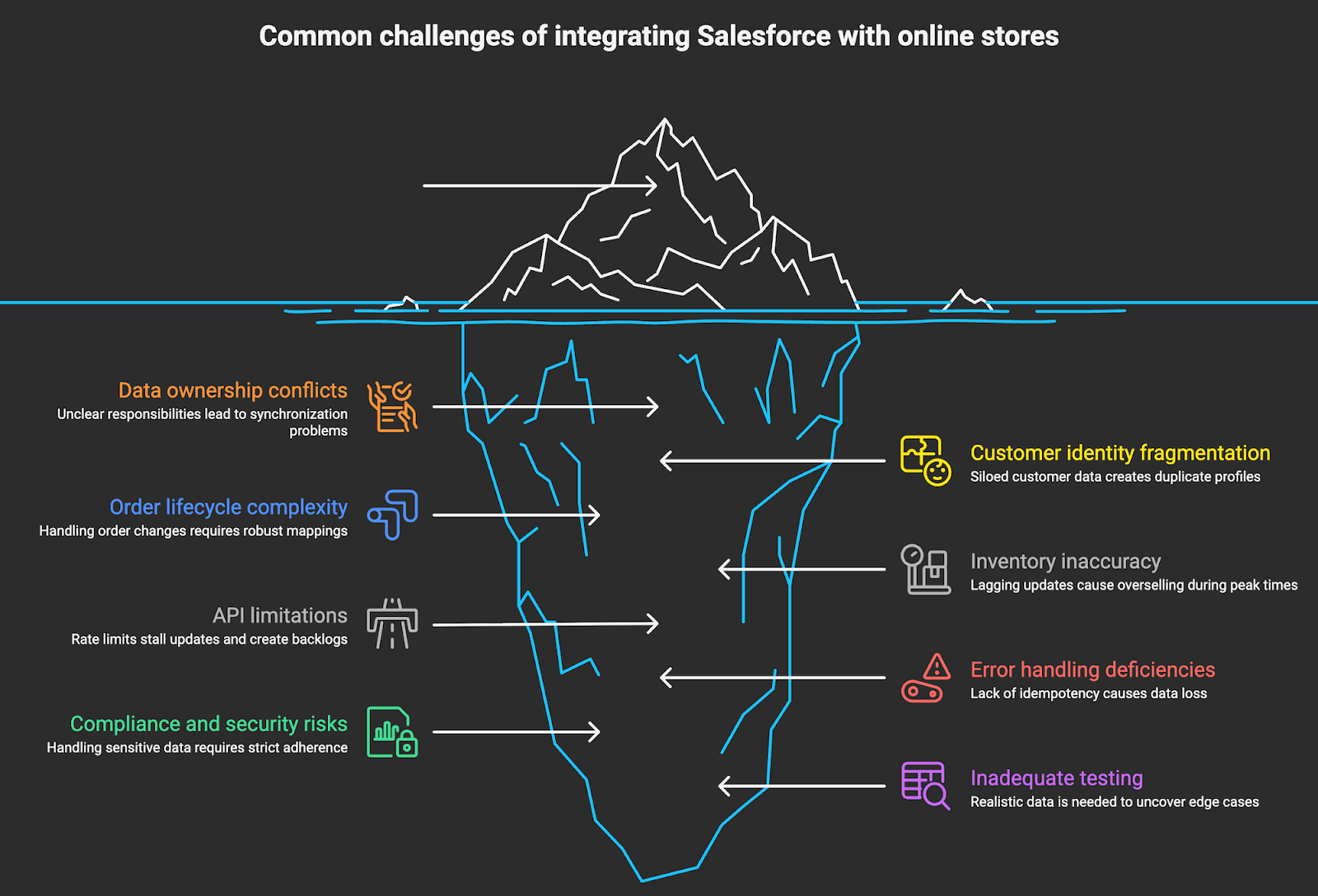Here is a clear path to deliver salesforce ecommerce integration that actually moves revenue, margin, and customer lifetime value. You will find which commerce platforms connect well with Salesforce, the main integration methods, where each method fits, and what pitfalls to avoid.
Use this to decide quickly, align teams, and set measurable targets for data quality, order sync latency, customer 360, and automation. We close with a short checklist and how Makeitfuture can help you stand up a resilient integration in weeks, not months.
WHAT IS SALESFORCE?
Salesforce is a cloud platform for managing customer relationships across sales, service, marketing, and commerce, often called Customer 360. It provides core applications like Sales Cloud, Service Cloud, Marketing Cloud, and Commerce Cloud, plus APIs, app marketplace, analytics, and data services that enable end to end digital workflows and personalization at scale. For data unification and identity resolution, Salesforce Data Cloud connects and harmonizes data from multiple sources to power AI and automation across the suite Salesforce Data Cloud overview.
E-COMMERCE PLATFORMS TO INTEGRATE WITH SALESFORCE
Integrating your store with Salesforce consolidates orders, products, inventory, and customer profiles. That unlocks segmented marketing, proactive service, and AI assisted selling without swivel chair work between systems. Below are platforms most teams connect to Salesforce, and why.
- Salesforce Commerce Cloud. Native B2C and B2B commerce that ties directly into Customer 360. Integration typically focuses on deepening data sharing with Sales, Service, Marketing, and Data Cloud for unified experiences and automation. Best for brands standardizing on Salesforce stack.
- Shopify. Popular for fast growing DTC and multichannel retail. Integrate to sync customers, orders, products, fulfillment status, and subscription data with Sales and Service Cloud, and to trigger journeys in Marketing Cloud. Shopify offers Admin and Storefront APIs, plus webhooks for event driven syncs. Shopify API docs.
- Magento, now Adobe Commerce. Flexible for complex catalogs and B2B features. Integration aligns complex order flows, negotiated pricing, and multi store catalogs with Salesforce and an MDM or Data Cloud backbone. Adobe exposes REST and GraphQL APIs. Adobe Commerce API docs.
- WooCommerce. A WordPress native option favored by content led brands. Integrate to push orders and customers into Salesforce for service, and to pull pricing and inventory from ERP via Salesforce as a hub. WooCommerce has REST APIs and webhooks. WooCommerce REST API.
- BigCommerce. Headless friendly, solid for multi storefront and marketplace setups. Integrate for real time inventory, order updates, and account based pricing sync with Salesforce B2B. BigCommerce provides REST and GraphQL APIs and webhooks. BigCommerce API docs.
Bottom line: connect commerce to Salesforce to create a single view of the customer, automate journeys, and coordinate sales, service, and fulfillment without manual effort.
HOW TO INTEGRATE SALESFORCE WITH YOUR E-COMMERCE PLATFORM
Your best path depends on speed to value, customization needs, transaction volume, and internal engineering capacity. Most organizations start with a connector to prove value, then extend with APIs for advanced logic and scale.
Pragmatic path: start with a connector to prove ROI and data quality, then layer API driven extensions for special cases like partial shipments, returns, multi warehouse inventory, or subscription entitlements.
- Define outcomes and KPIs. Examples, reduce order sync time to under 5 minutes, cut order status related tickets by 30 percent, drive a 10 percent lift in repeat purchase through better segmentation. Salesforce research shows customers expect consistent, connected experiences across channels, which integration directly enables State of the Connected Customer.
- Model your data and sources of truth. Decide which system owns Products, Price, Inventory, Customers, Orders, and Returns. Map fields and IDs, including external IDs for upserts in Salesforce.
- Choose an integration method. Balance speed, flexibility, and cost. For Shopify or WooCommerce with standard flows, a connector is typically sufficient. For Adobe Commerce with complex B2B pricing, prefer API based or custom.
- Design for events first. Use commerce webhooks and Salesforce Platform Events or Change Data Capture so updates flow in near real time without heavy polling Shopify webhooks, BigCommerce webhooks, Salesforce Platform Events.
- Secure and scale. Use OAuth, least privilege, rate limit awareness, idempotent processing, and dead letter queues. Monitor API consumption against Salesforce limits to avoid disruptions (Salesforce API limits).
- Pilot, then scale. Validate in a full copy sandbox with realistic data. Roll out incrementally by channel or market. Instrument dashboards for data freshness, error rates, and business impact.
COMMON CHALLENGES & BEST PRACTICES
Common challenges
- Conflicting data ownership. Product and pricing may live in ERP, while catalog variants sit in commerce. Without clear ownership, syncs fight each other.
- Duplicate customers and identities. Guest checkout, multiple emails, and channel silos fragment profiles.
- Order lifecycle complexity. Splits, partial shipments, edits, cancellations, and returns can break naive mappings.
- Inventory accuracy. Overselling happens when inventory updates lag or batch windows collide with traffic spikes.
- API limits and backpressure. Hitting Salesforce or platform API limits stalls updates and creates backlogs Salesforce API limits.
- Error handling and retries. Without idempotency keys and dead letter queues, duplicates and data loss creep in.
- Compliance and security. Handling payments and personal data touches PCI DSS and GDPR responsibilities.
- Testing with realistic data. Edge cases only appear with real sized catalogs, long tail variants, and historic orders.

Best practices
- Declare a source of truth per object. For example, ERP owns Inventory, Commerce owns Orders and Shipments, Salesforce owns Accounts and Cases. Enforce directional flows.
- Use event driven patterns. Subscribe to commerce webhooks and publish Salesforce Platform Events or Change Data Capture to keep systems in sync with minimal latency.
- Implement idempotency and external IDs. Use upsert with external IDs in Salesforce and include idempotency keys in writes to avoid duplicates External IDs in Salesforce.
- Batch wisely. Use Bulk API 2.0 for backfills and large catalog updates, stream events for day to day changes Bulk API 2.0.
- Protect API budgets. Cache static reads, debounce noisy updates, and design exponential backoff with dead letter queues.
- Harden observability. Track business SLIs, for example time to reflect an order in Salesforce, order update error rate, inventory last updated timestamp. Alert by severity.
- Close the loop with AI and journeys. Feed unified profiles to “Marketing Cloud” and “Data Cloud to drive” for next best offer, replenishment reminders, and proactive service.
- Segregate duties and use an integration user. Apply least privilege and OAuth scopes in Salesforce and commerce platforms Salesforce OAuth flows.
- Stage, test, and rehearse incident recovery. Use sandboxes and environments, run cutover playbooks, and test rollback paths before going live.
How can Makeitfuture help you with integrating Salesforce with E-Commerce?
Conclusion. Integrating your ecommerce stack with Salesforce turns siloed transactions into a compounding asset, a live customer graph that powers service, marketing, and sales. Choose the lightest weight method that delivers your KPIs, design for events first, and instrument the flows so you can scale with confidence. If requirements are standard, start with a connector. When differentiation and scale matter, extend with APIs and events.
Where we come in. Makeitfuture helps C suite, IT, and operations leaders stand up reliable salesforce ecommerce integration, with a focus on measurable impact and sustainable operations. We bring:
- Value first roadmap. We align on business KPIs, map sources of truth, and pick the right method for your constraints and timeline.
- Accelerators. Pre mapped data models for Shopify, Adobe Commerce, WooCommerce, BigCommerce, and Commerce Cloud. Reference architectures for event driven syncs using Platform Events and webhooks.
- Build and run. Connector deployments or API integrations with MuleSoft, Celigo, or serverless, plus observability, alerting, and devops. We also enable teams, not just ship code.
- AI enabled outcomes. We wire Data Cloud and Einstein so marketing and service immediately leverage unified profiles for personalization and automation.
Ready to scope a fast, low risk path to value? Explore our Salesforce and integration services and book a working session.

















.avif)
